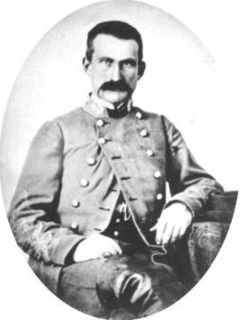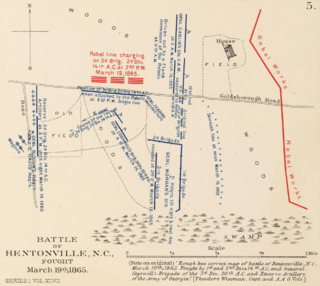
Mount Jackson is a town in Shenandoah County, Virginia, United States. The population was 1,994 at the 2010 census.

Fort Leavenworth is a United States Army installation located in Leavenworth County, Kansas, in the city of Leavenworth, roughly 20 miles northwest of Kansas City. Built in 1827, it is the second oldest active United States Army post west of Washington, D.C., and the oldest permanent settlement in Kansas. Fort Leavenworth has been historically known as the "Intellectual Center of the Army."

Benjamin Henry Grierson was a music teacher, then a career officer in the United States Army. He was a cavalry general in the volunteer Union Army during the Civil War and later led troops in the American Old West.

The First Battle of Newtonia was fought on September 30, 1862, between Confederate soldiers commanded by Colonel Douglas H. Cooper and a Union column commanded by Brigadier General Frederick Salomon near Newtonia, Missouri, during the American Civil War. Cooper's force had moved into southwestern Missouri, and encamped near the town of Newtonia. The Confederate column was composed mostly of cavalry led by Colonel Joseph O. Shelby and a brigade of Native Americans. A Union force commanded by Brigadier General James G. Blunt moved to intercept Cooper's force. Blunt's advance force, led by Salomon, reached the vicinity of Newtonia on September 29, and attacked Cooper's position on September 30. A Union probing force commanded by Colonel Edward Lynde was driven out of Newtonia by Cooper's forces on the morning of the 30th.

The American Civil War saw cavalry tactics move largely away from the offensive towards the defensive, with the emphasis on screening, raiding, and reconnaissance. Development of the rifled musket had also rendered the cavalry charge both impractical and detrimental.
The town of Romney, Virginia, traded hands between the Union Army and Confederate States Army no fewer than 10 times during the American Civil War, assuming the occupying force spent at least one night in the town. The story of the small town is emblematic of the many military campaigns that swept through western Virginia and, later, the new state of West Virginia.

John McCausland, Jr. was a brigadier general in the Confederate army, famous for the ransom of Hagerstown, Maryland, and the razing of Chambersburg, Pennsylvania, during the American Civil War.

Streight's Raid took place in northern Alabama during the American Civil War. It was led by Union Army Col. Abel Streight and opposed by Confederate Brig. Gen. Nathan Bedford Forrest. Streight's goal was to destroy parts of the Western and Atlantic Railroad, which was supplying the Confederate Army of Tennessee. The raid was poorly supplied and planned, and ended with the defeat of Streight and his 1,700 men at Cedar Bluff, Alabama, by Forrest who bluffed his opponent into surrendering to his 500 men. Streight was additionally hindered by locals throughout his march, while pursued by Forrest, who had the advantage of home territory and the sympathy and aid of the local populace, most famously Emma Sansom.

William Henry Harrison Cowles was a North Carolina Democratic politician who served four terms in the United States House of Representatives.
The 95th Regiment Illinois Volunteer Infantry was an infantry regiment that served in the Union Army during the American Civil War.

The New Haven Battlefield is the area of American Civil War military engagements at the intersection of the Rolling Fork and the former Louisville and Nashville Railroad line between Knoxville and New Haven, Kentucky. The geographic area includes the James Howell Farm and additional combat areas of December 30, 1862.

Louis Henry Carpenter was a United States Army brigadier general and a recipient of the Medal of Honor for his actions in the American Indian Wars.

Nicholas Merritt Nolan was a United States Army major. An Irish immigrant, he began his military career in New York on December 9, 1852 with the 4th Artillery, and subsequently served in New York's 2nd Dragoons. He enlisted as a private and rose through the ranks becoming a first sergeant. He was commissioned an officer in late 1862 in the Regular Army, while serving with the 6th U.S. Cavalry Regiment during the American Civil War. He participated in 16 campaigns with the 6th and most of its battles. He was slightly wounded at the Battle of Fairfield and seriously wounded at the Battle of Dinwiddie Court House. He was brevetted twice and noted at least twice for gallantry during combat. He was slightly wounded when captured at the end of March 1865, and was later paroled. After the Civil War, he served with the 10th U.S. Cavalry, known as the Buffalo Soldiers, for 14 years. Nolan is also noted for his pluses and minuses during the Buffalo Soldier tragedy of 1877 that made headlines in the Eastern United States. He was the commanding officer of Henry O. Flipper in 1878, the first African American to graduate from the United States Military Academy at West Point. He commanded several frontier forts before his untimely death in 1883.
Palo Alto is a ghost town in Clay County, Mississippi, United States. Established c. 1846, it is located at 33°40′50″N88°48′0″W at an elevation of 279 feet (85 m).

The Battle of Bentonville was fought in Johnston County, North Carolina, near the village of Bentonville, as part of the Western Theater of the American Civil War. It was the last battle between the armies of Union Maj. Gen. William T. Sherman and Confederate Gen. Joseph E. Johnston.

The state of Illinois during the American Civil War was a major source of troops for the Union Army, and of military supplies, food, and clothing. Situated near major rivers and railroads, Illinois became a major jumping off place early in the war for Ulysses S. Grant's efforts to seize control of the Mississippi and Tennessee rivers. Statewide, public support for the Union was high despite Copperhead sentiment.

Alexander W. Monroe was a prominent American lawyer, politician, and military officer in the U.S. states of Virginia and West Virginia. Monroe served as a member of the Virginia House of Delegates and West Virginia House of Delegates representing Hampshire County. He was the Speaker of the West Virginia House of Delegates during the 1875–1877 legislative session. Monroe also represented Hampshire County in the West Virginia Constitutional Convention of 1872.

Battery "K", 1st Illinois Light Artillery Regiment was an artillery battery from Illinois that served in the Union Army during the American Civil War. The battery was organized in January 1862 at Shawneetown and spent most of 1862–1863 on guard duty in western Kentucky. However, part of the battery participated in Grierson's Raid and the Siege of Port Hudson in 1863. The battery fought at Okolona, Tupelo, Spring Hill, and Franklin in 1864. The battery mustered out of Federal service in December 1864; new recruits and re-enlisted veterans transferred to Battery "E", 1st Illinois Light Artillery Regiment.

The Battle of Egypt Station was an engagement in Mississippi that took place during a successful Union cavalry raid during the American Civil War. A 3,500-man Union cavalry division under Brigadier General Benjamin Grierson defeated Confederate troops led by Franklin Gardner and Samuel J. Gholson. Grierson's raiding cavalry left Memphis, Tennessee on 21 December and first demolished a Confederate supply depot at Verona. Moving south while wrecking bridges and track along the Mobile and Ohio Railroad, the Union raiders encountered the Confederate defenders at Egypt Station. After their victory, Grierson's cavalry headed southwest to Vicksburg which it reached on January 5, 1865. The raiders destroyed a large amount of Confederate supplies and also damaged the Mississippi Central Railroad. Some of the men captured by Grierson's raiders proved to be former Union soldiers who volunteered to fight for the Confederacy rather than languish in prison camps. When John Bell Hood's army retreated into northern Mississippi after the Battle of Nashville, it was unable to obtain supplies because Grierson's raiders had damaged the railroad so badly.

The 3rd United States Colored Cavalry was a regiment in the United States Army organized as one of the units of the United States Colored Troops during the American Civil War. The regiment was originally formed in October 1863 at Vicksburg, Mississippi as the 1st Mississippi Cavalry Regiment. The unit soon began taking part in expeditions near Vicksburg. In February–March 1864, the regiment saw action at Yazoo City. After being renamed the 3rd U.S. Colored Cavalry in March 1864, the regiment continued to participate in raids, including the Yazoo City expedition in May. In December 1864, the unit took part in a successful raid led by Benjamin Grierson during which the Battle of Egypt Station and other actions were fought. The regiment operated near Memphis, Tennessee, until April 1865, after which it returned to Vicksburg for occupation duties. The soldiers were mustered out of federal service in January 1866.



















